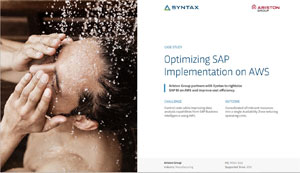Live from SAPinsider Studio: EV Technologies on the Evolution of BI
SAP Mentors Eric Vallo and Dallas Marks Discuss the Changing BI Landscape
SAP Mentors Eric Vallo and Dallas Marks of EV Technologies join SAPinsider Studio at BI-HANA 2016 to discuss fundamental changes to enterprise business intelligence (BI). Topics of this discussion include tips on moving the analytics needle, data management strategy for the digital enterprise, and what a transition to “pervasive BI” means to businesses from a technology perspective.
This is an edited version of the transcript:
Ken Murphy, SAPinsider: Hi, this is Ken Murphy with SAPinsider and I’m at the SAPinsider BI-HANA-IoT event in Las Vegas. This afternoon I am pleased to be joined by Eric Vallo and Dallas Marks of EV Technologies and SAP mentors. Thanks for being with us today.
Dallas Marks, EV Technologies: Thank you.
Eric Vallo, EV Technologies: Thank you.
Ken: Can you introduce yourselves and your role and responsibilities?
Dallas: I’m a pre-sales consultant with EV Technologies, and I help customers identify the right solution and then help work with our implementation teams and hand things off.
Eric: I’m CEO and chief nerd, I still love to work with customers and discover what they want to do with analytics and help guide them there.
Ken: There’s a lot of talk today about analytics and for organizations to become data-driven and get on that track. What advice do you have for where to start, and how to get on that path toward becoming more data-driven?
Eric: I think that first understanding at its core how a line of business or business user wants to consume information is absolutely paramount. We fall into the trap as IT practitioners of thinking sometimes we know what’s best as a solution so it really starts with the fundamental people and process and understanding how I can move the needle for analytics in an organization and generate revenue or avoid costs and ultimately turn that into a solution that can be consumable by my users.
Ken: And Dallas, there is some confusion about what solutions to use; what advice do you have for organizations to avoid being overwhelmed with the decisions they have to make about which tools to use?
Dallas: There are a lot of tools, both from SAP and obviously SAP has competitors in the space. But I think organizations need to feel comfortable that there’s really not one right path. And there’s no silver bullet, and it’s really a combination of what you may be currently comfortable with or already using. But also keeping that open mind again going back to what kinds of requirements your business users are articulating and then just trying to find the best fit.
Ken: Today, there’s a big focus on predictive analytics, predictive modeling, advanced analytics – not just analytics 101 I guess. How did we get to where we are today, how did it advance to this stage?
Eric: I think it’s been a really long road. Technology was a huge barrier for a long time; the process of ideation around a model and the time it takes to develop it, implement it, score it, and use it within a business process in six weeks at best. The progression of technology today makes it so that I don’t have to have a propeller head, I don’t have to have the PhD necessarily to put a toe in the water for predictive; I’m able to use tools quickly, profile the data, explore it, and let the technology help guide me toward a possible prediction.
Ken: Does the influx of data volume and complexity change the way organizations have to look at data management issues?
Eric: Absolutely. Once again, user perception is everything and – again as IT practitioners, BI practitioners – if we’re not sensitive to think times, how responsive my apps are or how they’re going to consume information, users are going to lose interest, they’re going to blame the tools. It’s going to degrade user confidence in what we build. And so data management strategies are complemented nicely by technology today. I can put together strategies that balance large volumes of data in the speed in which users want to consume it, and in the way they want to visualize it – in smart ways, not just I’m going to start a report and go to lunch and hope it’s finished by the time I get back.
Dallas: It just means that companies also need to be open to setting some time aside to actually investigate some of the investments. Hadoop has moved from the fringe – Facebook is using it now – to more mainstream, we need a place to store ever-increasing amounts of data. And we also need a way to extract value out of it. So those may be unfamiliar tools in your organization so you have to figure out, you have to be in a position to make a valid recommendation.
Ken: For a company that is moving to a modern analytics platform, what advice do you have to avoid upheaval in the organization as far as push-back, people are happy with the way things are. How do you encourage adoption in leading to a more modern platform?
Eric: First, understanding once again the needs of the users. Often, it doesn’t make sense to rip out a tool and replace it for the sake of doing so. But where we can complement and enhance capabilities whether it be through a cloud offering or maybe we don’t already have predictive. We have to create the use cases with the business to identify where can we have potential wins, how do we define a pilot that can add value vs. a POC which might be throwaway and disposable assets. Those don’t necessarily make a lot of sense. And use those as a driver to excite the business to generate new ideas and help bring those to fruition.
Dallas: It’s also about understanding really what the direction of the business is as opposed to what the direction of the technology is. So are we trying to increase revenue? Are we trying to decrease customer churn? What KPIs are we trying to align the business to, and then just making sure that the technology choices are in support of those goals and not working against them.
Eric: One of the things that we spoke about was the definition of BI itself is fundamentally changing. We’ve gone from how is my user adoption of what I built, to this idea of pervasive BI. If I Google my stock price, there’s a chart, there’s a visualization. If I Google the weather, Google neatly shows me a line chart which demonstrates the movement in temperature. And so where we begin to make these solutions thoughtless, where we lead our user toward inclusion vs. data that they have to make conclusions upon. We’ve moved beyond tabular reports and dashboards to taking useful information and quickly making a decision on it.
Ken: At this event there’s a lot of discussion about SAP Cloud for Analytics. I’m curious to hear your thought on what kind of impact Cloud for Analytics is going to have in the analytics space?
Dallas: I think it really depends in the short-term where a customer’s data is. If a customer’s data is currently in the cloud, then it’s going to make sense to use a cloud-based solution to interact with that data. If most of your data is on-premise, then it’s going to make more sense to have an on-premise solution. I think the important thing is that SAP is recognizing that both of those scenarios exist, and that over time there is going to be the hybrid scenario where some of the data is in the cloud and some is on-premise and we need tools that don’t really care where the data is.
Eric: The idea of a hybrid landscape isn’t necessarily a new one, but it’s encouraging to see SAP acknowledging that out of the gates. Some of the top challenges you experience when you talk to a customer about implementing analytics in the cloud are performance, security, and cost. And so what will be interesting to see is if Cloud for Analytics actually addresses several of those check-boxes through the way to stream data from HANA and BW and for those customers that have that existing deep investment in SAP’s platforms.
Ken: Thanks for being with me today.
Eric and Dallas: Thank you.








